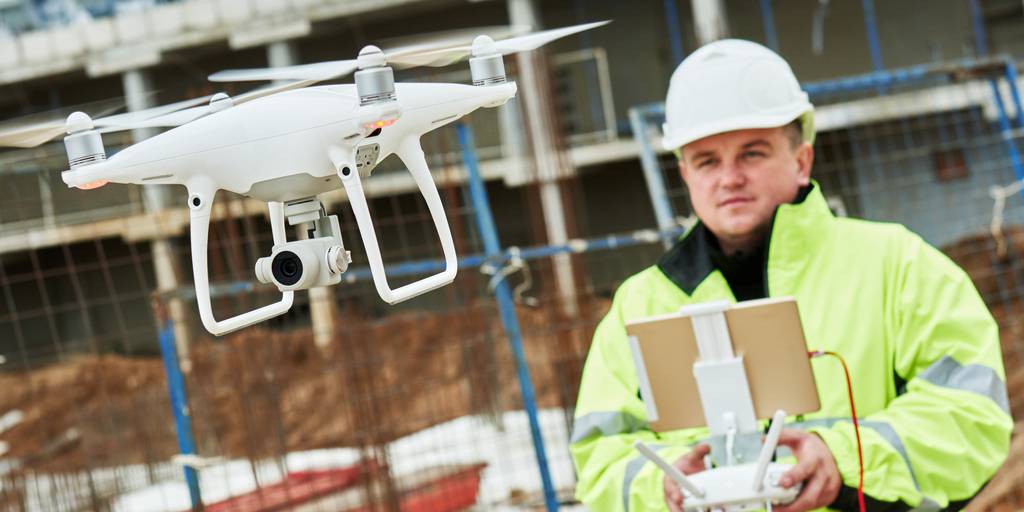Technology is constantly improving the way the construction industry operates. Smartphones and mobile apps have made communication and collaboration on projects easier. Building Information Modeling (BIM) improves project visualization, makes scheduling more efficient and reduces waste and rework.
One aspect that often goes overlooked is how technology can be leveraged to improve construction site safety. Construction remains one of the deadliest occupations with 937 worker deaths in 2015, according to the most recent Census of Fatal Occupational Injuries (CFOI) from the Bureau of Labor Statistics (BLS).
This has been changing in the past few years as companies realize that technology can be used to better protect their workers. Here are a few ways that technology is being used to make construction sites safer:
Drones
The commercial use of unmanned aerial vehicles, commonly referred to as drones, has really taken off ever since the Federal Aviation Administration (FAA) established rules for their use last year.
In construction, drones are being used on jobsites for everything from site surveying to inspecting structures to creating promotional videos. They are also being used to make construction sites safer.
Drones can be used to quickly conduct jobsite inspections and identify potential hazards each day. They can also be used to monitor workers throughout the day to ensure everyone is working safely. Drones are being used to take photos of as work progresses create as-built models of jobsites to keep everyone informed of the changing work conditions each day.
Exoskeletons
Exoskeletons and power-assist suits are being developed for industrial use so workers can lift and carry objects or use heavy tools for longer periods of time without putting undue stress and strain on the body.
Unpowered devices like those developed by companies like Ekso Bionics and StrongArm Technologies are designed to reduce fatigue and injury and maintain proper posture. These devices use counterweights or redistribute loads to stronger muscles to make lifting and carrying easier.
Powered suits, like those developed by companies like Daewoo and Panasonic, uses sensors and motors to assist workers by reducing back strain and allowing them to lift heavy objects.
Virtual Reality
Virtual reality simulators have been used for years to train soldiers, pilots and surgeons and could be used the same way to train workers on everything from operating cranes and excavators to doing welding and masonry work.
Safety training and equipment operator training are two areas where virtual reality could impact construction in the future. Workers could get exposure to environments such as confined spaces or working at height in a controlled environment.
Wearables
Human Condition, a New York-based think tank, is developing construction wearables with a focus on eliminating injuries and fatalities caused by OSHA’s Fatal Four Hazards: falls, struck-by, electrocution and caught-in/between.
They’ve designed a safety vest and hard hat that integrates low-cost wearable computers, sensors, GPS and real-time locating systems (RTLS). The hard hat would be equipped with solar chargers and the safety vest would have kinetic chargers to power them. The safety vest includes an airbag collar that would inflate should a worker fall and would monitor vital signs and repetitive motions.
The hard hat has built-in LEDs that does double duty as both a work light and a safety beacon. The data gathered from these devices can be accessed through the cloud with a mobile interface in real-time so site supervisors can keep an eye on all the workers at a jobsite.
Smart clothing, or e-textiles, that can monitor vital signs like respiration rate, skin temperature, and heart rate will also make their way to the construction site. These wearables will be able to monitor a worker’s posture, track movements, determine if they are suffering from fatigue and whether they are intoxicated or under the influence of narcotics. Keeping a watchful eye on workers can help predict an accident before it occurs.
Self-Driving Trucks & Heavy Equipment
Crash trucks equipped with attenuators have been used for years in highway work zones to protect workers and motorists. Royal Truck & Equipment has developed an autonomous Truck Mounted Attenuator (TMA) truck to protect the one person still at risk when crash trucks are used, the driver.
The driverless crash trucks follow a lead vehicle that would transmit GPS information back to the crash truck instructing it when to turn, brake and what speed to travel.
Heavy equipment manufacturers, like Komatsu and Caterpillar, have machines capable of operating autonomously or being controlled remotely. This type of technology allows operators to be completely removed from the machine to eliminate injuries from potential rollovers and other hazards. In addition to the safety aspect, these intelligent machines are also highly efficient so productivity can remain high.
Site Sensors
Companies like SmartSite and Pillar Technologies have developed site sensors that can be deployed across a construction site to monitor things like temperature, noise levels, dust particulates and volatile organic compounds to help limit exposure to workers.
The sensors are mounted throughout the construction site and can alert workers immediately when they are at risk from permissible exposure levels being reached. Data from the sensors are collected and can be analyzed to mitigate exposure levels and keep workers safe and stay compliant with OSHA regulations.
What technology have you deployed to make your construction sites safer? Let us know in the comments below.
